4.1: Identifying Potatoes
- Page ID
- 21214
\( \newcommand{\vecs}[1]{\overset { \scriptstyle \rightharpoonup} {\mathbf{#1}} } \)
\( \newcommand{\vecd}[1]{\overset{-\!-\!\rightharpoonup}{\vphantom{a}\smash {#1}}} \)
\( \newcommand{\id}{\mathrm{id}}\) \( \newcommand{\Span}{\mathrm{span}}\)
( \newcommand{\kernel}{\mathrm{null}\,}\) \( \newcommand{\range}{\mathrm{range}\,}\)
\( \newcommand{\RealPart}{\mathrm{Re}}\) \( \newcommand{\ImaginaryPart}{\mathrm{Im}}\)
\( \newcommand{\Argument}{\mathrm{Arg}}\) \( \newcommand{\norm}[1]{\| #1 \|}\)
\( \newcommand{\inner}[2]{\langle #1, #2 \rangle}\)
\( \newcommand{\Span}{\mathrm{span}}\)
\( \newcommand{\id}{\mathrm{id}}\)
\( \newcommand{\Span}{\mathrm{span}}\)
\( \newcommand{\kernel}{\mathrm{null}\,}\)
\( \newcommand{\range}{\mathrm{range}\,}\)
\( \newcommand{\RealPart}{\mathrm{Re}}\)
\( \newcommand{\ImaginaryPart}{\mathrm{Im}}\)
\( \newcommand{\Argument}{\mathrm{Arg}}\)
\( \newcommand{\norm}[1]{\| #1 \|}\)
\( \newcommand{\inner}[2]{\langle #1, #2 \rangle}\)
\( \newcommand{\Span}{\mathrm{span}}\) \( \newcommand{\AA}{\unicode[.8,0]{x212B}}\)
\( \newcommand{\vectorA}[1]{\vec{#1}} % arrow\)
\( \newcommand{\vectorAt}[1]{\vec{\text{#1}}} % arrow\)
\( \newcommand{\vectorB}[1]{\overset { \scriptstyle \rightharpoonup} {\mathbf{#1}} } \)
\( \newcommand{\vectorC}[1]{\textbf{#1}} \)
\( \newcommand{\vectorD}[1]{\overrightarrow{#1}} \)
\( \newcommand{\vectorDt}[1]{\overrightarrow{\text{#1}}} \)
\( \newcommand{\vectE}[1]{\overset{-\!-\!\rightharpoonup}{\vphantom{a}\smash{\mathbf {#1}}}} \)
\( \newcommand{\vecs}[1]{\overset { \scriptstyle \rightharpoonup} {\mathbf{#1}} } \)
\( \newcommand{\vecd}[1]{\overset{-\!-\!\rightharpoonup}{\vphantom{a}\smash {#1}}} \)
\(\newcommand{\avec}{\mathbf a}\) \(\newcommand{\bvec}{\mathbf b}\) \(\newcommand{\cvec}{\mathbf c}\) \(\newcommand{\dvec}{\mathbf d}\) \(\newcommand{\dtil}{\widetilde{\mathbf d}}\) \(\newcommand{\evec}{\mathbf e}\) \(\newcommand{\fvec}{\mathbf f}\) \(\newcommand{\nvec}{\mathbf n}\) \(\newcommand{\pvec}{\mathbf p}\) \(\newcommand{\qvec}{\mathbf q}\) \(\newcommand{\svec}{\mathbf s}\) \(\newcommand{\tvec}{\mathbf t}\) \(\newcommand{\uvec}{\mathbf u}\) \(\newcommand{\vvec}{\mathbf v}\) \(\newcommand{\wvec}{\mathbf w}\) \(\newcommand{\xvec}{\mathbf x}\) \(\newcommand{\yvec}{\mathbf y}\) \(\newcommand{\zvec}{\mathbf z}\) \(\newcommand{\rvec}{\mathbf r}\) \(\newcommand{\mvec}{\mathbf m}\) \(\newcommand{\zerovec}{\mathbf 0}\) \(\newcommand{\onevec}{\mathbf 1}\) \(\newcommand{\real}{\mathbb R}\) \(\newcommand{\twovec}[2]{\left[\begin{array}{r}#1 \\ #2 \end{array}\right]}\) \(\newcommand{\ctwovec}[2]{\left[\begin{array}{c}#1 \\ #2 \end{array}\right]}\) \(\newcommand{\threevec}[3]{\left[\begin{array}{r}#1 \\ #2 \\ #3 \end{array}\right]}\) \(\newcommand{\cthreevec}[3]{\left[\begin{array}{c}#1 \\ #2 \\ #3 \end{array}\right]}\) \(\newcommand{\fourvec}[4]{\left[\begin{array}{r}#1 \\ #2 \\ #3 \\ #4 \end{array}\right]}\) \(\newcommand{\cfourvec}[4]{\left[\begin{array}{c}#1 \\ #2 \\ #3 \\ #4 \end{array}\right]}\) \(\newcommand{\fivevec}[5]{\left[\begin{array}{r}#1 \\ #2 \\ #3 \\ #4 \\ #5 \\ \end{array}\right]}\) \(\newcommand{\cfivevec}[5]{\left[\begin{array}{c}#1 \\ #2 \\ #3 \\ #4 \\ #5 \\ \end{array}\right]}\) \(\newcommand{\mattwo}[4]{\left[\begin{array}{rr}#1 \amp #2 \\ #3 \amp #4 \\ \end{array}\right]}\) \(\newcommand{\laspan}[1]{\text{Span}\{#1\}}\) \(\newcommand{\bcal}{\cal B}\) \(\newcommand{\ccal}{\cal C}\) \(\newcommand{\scal}{\cal S}\) \(\newcommand{\wcal}{\cal W}\) \(\newcommand{\ecal}{\cal E}\) \(\newcommand{\coords}[2]{\left\{#1\right\}_{#2}}\) \(\newcommand{\gray}[1]{\color{gray}{#1}}\) \(\newcommand{\lgray}[1]{\color{lightgray}{#1}}\) \(\newcommand{\rank}{\operatorname{rank}}\) \(\newcommand{\row}{\text{Row}}\) \(\newcommand{\col}{\text{Col}}\) \(\renewcommand{\row}{\text{Row}}\) \(\newcommand{\nul}{\text{Nul}}\) \(\newcommand{\var}{\text{Var}}\) \(\newcommand{\corr}{\text{corr}}\) \(\newcommand{\len}[1]{\left|#1\right|}\) \(\newcommand{\bbar}{\overline{\bvec}}\) \(\newcommand{\bhat}{\widehat{\bvec}}\) \(\newcommand{\bperp}{\bvec^\perp}\) \(\newcommand{\xhat}{\widehat{\xvec}}\) \(\newcommand{\vhat}{\widehat{\vvec}}\) \(\newcommand{\uhat}{\widehat{\uvec}}\) \(\newcommand{\what}{\widehat{\wvec}}\) \(\newcommand{\Sighat}{\widehat{\Sigma}}\) \(\newcommand{\lt}{<}\) \(\newcommand{\gt}{>}\) \(\newcommand{\amp}{&}\) \(\definecolor{fillinmathshade}{gray}{0.9}\)Potatoes are one of the few vegetables native to the New World, probably originating in the South American Andes. Botanically, potatoes are succulent, non-woody annual plants. The portion consumed is the tuber, the swollen fleshy part of the underground stem. Potatoes are hardy and easy to grow, making them inexpensive and widely available. Americans eat nearly 50-pounds of potatoes annually, making potatoes one of the top 20 vegetables in the United States.
Identifying Potatoes
Discussed here are some of the more commonly used types of potatoes. Other varieties are regularly being developed or rediscovered and tested in the market place. New potatoes are small, immature potatoes (of any variety) that are harvested before their starches develop. Although red potatoes can be "new," not all new potatoes are necessarily red-skinned. Conversely, not all reel-skinned potatoes are new. True new potatoes are waxy with a high moisture content and a thin, delicate skin.
Select potatoes that are heavy and very firm with clean skin and few eyes. Avoid those with many eyes, sprouts, green streaks, soft spots, cracks or cut edges. Most varieties are available all year. When ordering potatoes, note that size A is larger than size B, which must be between 1 1/2 and 2 1/4 inches (3.75 and 5.5 centimeters) in diameter.
Fingerlings
Fingerling potatoes are typically heirloom varieties, related to the original potato varieties from the Andes. They are generally small, long and finger-shape d or oblong with good flavor. The Russian Banana look s like a small banana and has a firm texture and rich, buttery flavor. The reel-streaked French Fingerling has a nutty flavor while the red Ruby Crescent has a strong, earthy flavor. All fingerling varieties tend to be low in starch and are good for roasting and in potato salads.
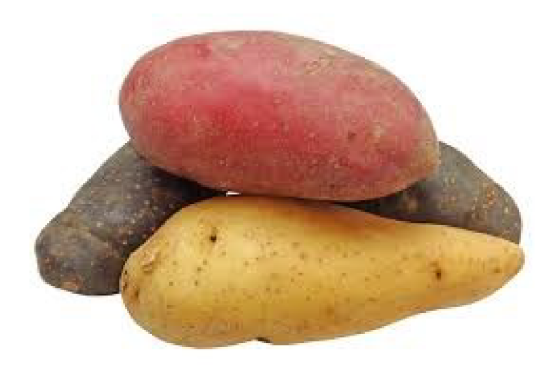
Purple Potatoes
Purple (or blue) potatoes have a deep purple skin. The flesh is bright purple, becoming lighter when cooked. They are mealy, with a flavor and texture similar to russets. The most common varieties are All Blue and Caribe, which were also quite popular in the mid-19th century.
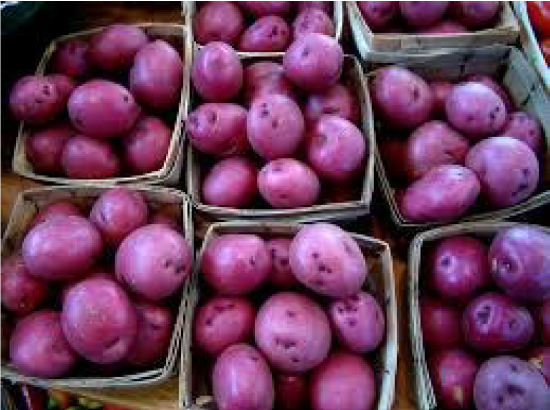
Red Potatoes
Red potatoes have a thin red skin and crisp, white, waxy flesh, best suited to boiling or steaming. They do not have the dry, mealy texture that successful baking requires. Red potatoes are round, instead of long or oblong; popular varieties are Red Pontiac and Norland.
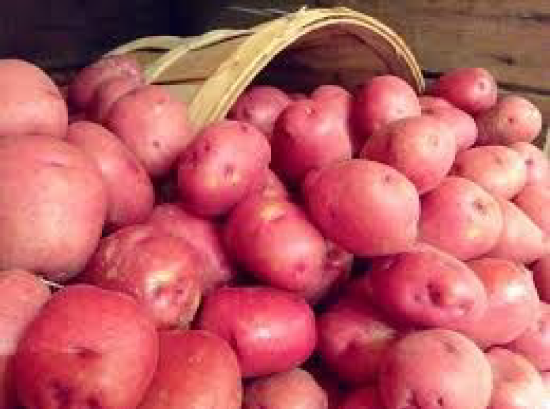
Russet (Burbank) Potatoes
Russet potatoes, commonly referred to as Idaho potatoes, are the standard baking potato. They are long with rough, reddish-brown skin and mealy flesh. Russets are excellent baked and are the best potatoes for frying. They tend to fall apart when boiled. They are marketed in several size categories and should be purchased in the size most appropriate for their intended use.
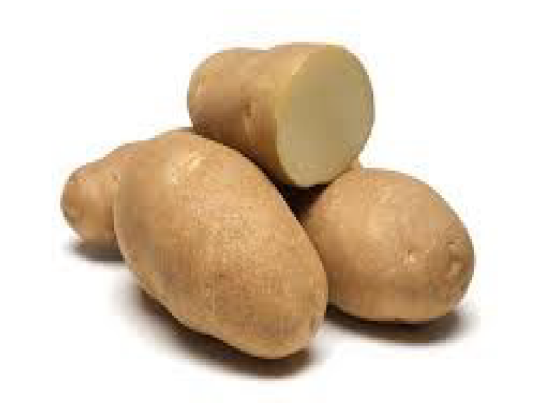
White Potatoes
White potatoes are available in round or long varieties. They have a thin, tender skin with a tender, waxy yellow or white flesh. Round white potatoes are also referred to as all-purpose potatoes. White potatoes are usually cooked with moist heat or used for sautéing. White Rose and Finnish Yellow (or Yellow Finn) are popular varieties.
Another variety of white potato known as the Yukon Gold is a medium-sized, slightly flattened, oval potato. They have a delicate pa le yellow skin with shallow pink eyes. Their pale yellow flesh has a creamy texture and rich, buttery, nutty flavor. Yukon Gold potatoes are suitable for most cooking methods and will retain their yellow color when baked, boiled or fried. First bred by botanists in Canada, Yuk on Golds are now grown throughout the United States. Other lesser-known gold-fleshed varieties include Michigold, Donna, Delta Gold, Banana, and Saginaw Gold.
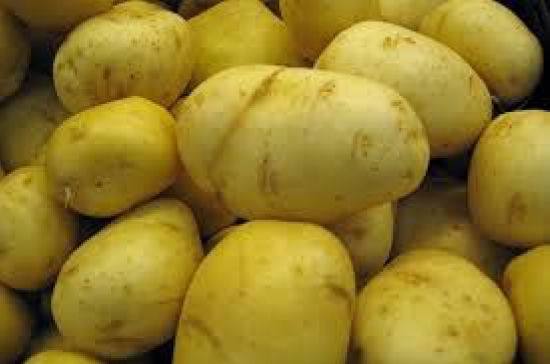
Sweet Potatoes
Sweet potatoes are from a different botanical family than ordinary potatoes, although they are also tuber s that originated in the New World. Two types are commonly available. One has yellow flesh and a dry, mealy texture; it is known as a boniato, white or Cuban sweet potato. The other has a darker orange, moister flesh and is high in sugar; it is known as a reel sweet potato. Both types have thick skins ranging in color from light tan to brownish red. (Sometimes dark-skinned sweet potatoes are erroneously labeled yams.) Sweet potatoes should be chosen according to the desired degree of sweetness. They are best suited for boiling, baking and pureeing, although the less sweet varieties can be deep-fried. The coo ked flesh can also be used in breads, pies and puddings. Sweet potatoes are available canned, often in a spiced or sugary sauce.
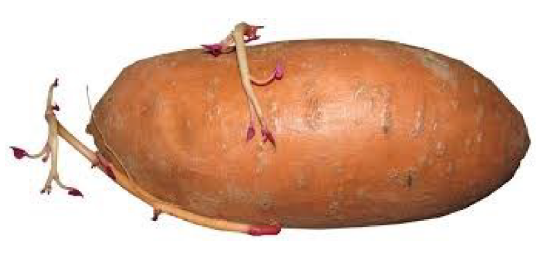
Yams
Yams are a third type of tuber, botanically different from both sweet and common potatoes. Yams are less sweet than sweet potatoes, but they can be used interchangeably. The flesh of yams ranges from creamy white to deep red. Yams are Asian in origin and are now found in Africa, South America and the southern United States.
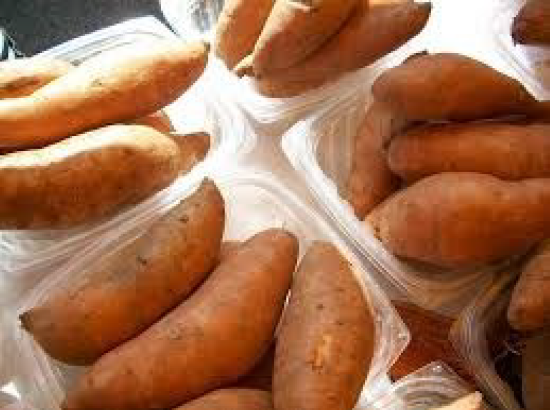
Nutrition
Potatoes contain a high percentage of easily digested complex carbohydrates and little or no fat. They are also a good source for minerals and vitamins, especially vitamin B6, vitamin C and potassium, although much of the vitamin C can be destroyed when potatoes are cooked in liquid such as for boiled or mashed potatoes.


